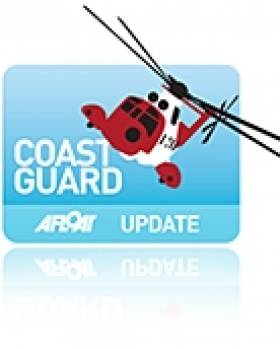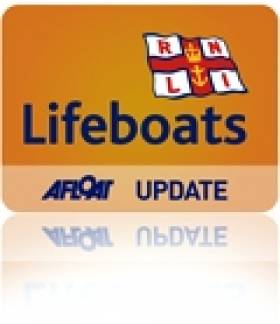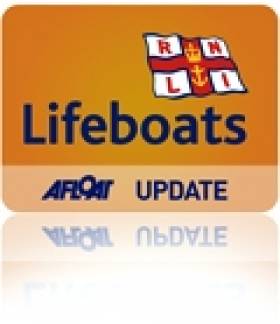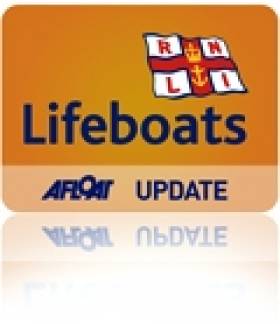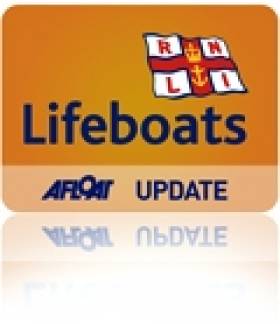Displaying items by tag: Valentia
Valentia and Malin Head Stations Now Both Under Threat
#COASTGUARD - Coastal communities in Kerry have joined those in Donegal protest against plans to close the Malin and Valentia coastguard stations.
In last Friday's This Island Nation, Tom MacSweeney discussed the attempts by management at the Irish Coast Guard to centralise radio operations in Dublin, commenting on the "vital component" of the stations' staff's local knowledge.
As previously reported on Afloat.ie, Minister for Transport Leo Varadkar said he would begin an action plan due in October to deal with issues outlined in a recent 'value for money' report which may require "tough decisions", including the closure of a coastguard radio station at Malin or Valentia.
Donegal TD Charlie McConalogue had already asked the Government for assurances on the future of Malin Head, which he said "has provided and invaluable service for over a century".
But the Sunday Independent has learned that now both stations are earmarked for closure, and reports that the Valentia Save Our Station group is concerned the minister is looking at an "alternative technical solution" by installing coastguard equipment from the west coast in his own constituency in Blanchardstown.
All this is despite the scheduled installation of hundreds and thousands of euro worth of new equipment in the Valentia station, which currently handles two-thirds of all major search and rescue operations annually, according to the Irish Examiner.
The change in plans has come as a surprise, the Examiner says, after similar proposals under the previous government were halted following pressure from backbench TDs.
Lough Derg Lifeboat Launches for Broken Down Motor Boat
At 19.31hrs the lifeboat launched with helm Eleanor Hooker, Ger Egan and Ben Roynane on board. Winds were west south-west, Force 4, visibility was fair with darkness falling. After drifting for some distance, the skipper had dropped anchor to prevent being grounded. They were located by the lifeboat behind the Carrigeen Islands, close to the County Clare Shore.
The three persons on board were all safe and wearing lifejackets. The lifeboat was alongside the casualty vessel, a 28ft motor boat at 19.50hrs. With an RNLI crew member on board, a tow line was set up. The anchor was held fast and given the conditions and nightfall, it was left behind. The vessel was towed to Dromineer Harbour and tied up safely alongside at 20.40hrs. The lifeboat returned to station and was ready for service again at 21.00hrs.
While it might be an exaggeration to say that all of the 21 crew members of Rambler 100 owe their lives to the Irish Search and Rescue service, there are certainly five people whose future prospects were greatly improved by the operation off the Fastnet Rock on August 15th. A lot of media focus has been on Coxswain Kieran Cotter and the crew of Baltimore Lifeboat as well as lifeboat mechanic Jerry Smith, whose dive boat, on charter to the media team of one of the competitors, was on hand to search and recover the five drifting crew. There is no question that this focus is appropriate. RNLI crews all over the UK and Ireland deserve the attention, not only because of their extraordinary voluntary dedication to the cause, but also because such publicity helps swell the coffers of the charity. The service could not operate without the generosity of the donors and incidents such as these help fill the blue boat-shaped boxes held by even more RNLI volunteers.

Saved: Ireland's Rescue Services Answered the Call of the capsized Supermaxi Rambler 100 off the Fastnet Rock. Photo: Team Phaedo
The dramatic stories and pictures dominating the media show the front line of a quite wonderful resource that is Search and Rescue in Ireland today. Baltimore Lifeboat was at the coal face of an intricate network of operations, triggered by the crew's EPIRBs. Irish Coast Guard radio officers in Valentia responded almost immediately tasking the rescue resources, working the phones and computers to confirm that this was not an accidentally triggered EPIRB, contacting RORC HQ, determining search patterns and relaying the information to the scene. It was the backroom contacts between RORC and the Coast Guard in endeavouring to contact Rambler 100 using satellite phones that confirmed the possibility of a catastrophic incident involving the Supermaxi. The subsequent tasking of the Shannon and Waterford based Sikorsky helicopters led to the medevac of crew member Wendy Touton and timely treatment of her hypothermic condition, initially by the on-board paramedics and later at Tralee General hospital. And Coast Guard involvement didn't end with the successful rescue – the shoreside operation to provide food and shelter in Baltimore was coordinated by Coast Guard personnel and the salvage operation of the hull of Rambler 100 was overseen by the Irish Coast Guard.

Rambler crew are recovered from the water after a SAR operation by the Irish Coastguard Photo: Team Phaedo. More photos here.
That Ireland has probably one of the best Search and Rescue services in the world goes back to the campaign initiated in 1988 by Joan McGinley, following the death, within sight of land of Donegal fisherman John Oglesby, whose leg was severed in a trawl winch. Eamon Doherty, the late former Garda Commissioner chaired the review group established in response to the campaign and his report led to the establishment of the Irish Marine Emergency Service, subsequently the Irish Coast Guard. Under the guidance of Director Capt Liam Kirwan, the new service moved quickly to become not only the central co-ordinating body for Search and Rescue, but developed its own resources, notably the helicopters, previously tasked in from Irish Air Corps and UK SAR.
Another element that will feature in the Rambler 100 incident is the Marine Casualty Investigation Board (MCIB), set up from recommendations arising from a review of the handling of investigations into marine casualties.
It might be thought that the incident is now closed, but there are many unanswered questions and the investigation will be looking at these and making recommendations that should improve safety in this sector. These questions will include EPIRB performance, liferaft deployment and grab bag usage, but perhaps the key issue yet to be determined is why the response from fellow competitors didn't appear to happen. Even if Channel 16 wasn't being actively monitored, and if not why not, shouldn't the Mayday set off by the Coast Guard have set off the DSC alerts on the radios of Rambler 100's fellow competitors? Had the incident occurred several hours later or earlier when Rambler 100 could have been up to 100 miles from the nearest land, when conditions worsened, we could be looking at much more serious consequences.
It is heartening to think that, in this small country of ours in troubled times, not only do we have a shining star in our search, rescue, recovery and restore system, involving professionals and volunteers cooperating for the greater good, we also have a system that determines the nature of incidents so that we can all learn from the experience.
And let us not forget those people and services, such as the Gardai, Navy, Army and the community of Baltimore who are outside the media spotlight who contributed to this happy ending.
Afloat's Latest Coastguard News
Afloat's Latest RNLI Lifeboat News
Afloat's Latest MCIB News
Coast Guard in Fourth Medical Evacuation This Week
The incident was co-ordinated by the Marine Rescue Co-ordination Centre of the Irish Coast Guard at Valentia which tasked the Shannon-based helicopter this morning to travel with an A&E Registrar from Cork University Hospital to treat the injured crew member en-route. Crews on these helicopter are also trained to paramedic standard. The helicopter arrived on scene at 14:37pm this afternoon and crew and medical personnel administered treatment to the casualty. The helicopter travelled onward to Tralee Regional Hospital where it arrived at approximately 16:30pm this afternoon. The Air Corps Casa aircraft provided top-cover for the helicopter during this incident.
On Saturday July 2, Lough Derg RNLI Lifeboat launched, following a request by Valentia Coast Guard, to assist two persons on board a 22ft motor cruiser, that had suffered engine failure and was drifting close to rocks on the Urra shore. The Lifeboat with helm Eleanor Hooker, Ger Egan and Dom Sharkey on board, launched at 19.30hrs. Winds were southwesterly, Force 2. The lifeboat arrived on scene 19.35hrs. The two persons were safe and unharmed and both wearing life-jackets. The vessel was taken under tow, and tied safety alongside at the public harbour at Dromineer at 19.55hrs. The skipper of the vessel thanked the lifeboat crew and said that when he 'saw smoke coming from the engine, he had no option but to cut the power and call for help". He was reassured by the crew that he had done the right thing. The lifeboat returned to station and was ready for service again at 20.20hrs.
At 17.23hrs on Friday July 1, Lough Derg RNLI Lifeboat was requested to launch by Valentia Coast Guard, to assist two persons in difficulty in the water, after their jet ski failed close by the Scilly Islands, at the south-western end of Lough Derg. The Lifeboat with helm Peter Clarke, Eleanor Hooker and Ger Egan on board, launched at 17.35hrs. Soon after launching, the lifeboat was informed that a lakeboat was also going to the assistance of the persons in the water. The lifeboat arrived on scene 17.55hrs. The crew spoke to fishermen in the only lakeboat in the vicinity. The fishermen had no English but conveyed to the crew that they had taken the jet ski and the persons to a landing place on the Tipperary shore. Lifeboat crew searched the Tipperary shoreline indicated by the fishermen, including private harbours, but were unable to locate the jet-skiers or their jet-ski. The Coast Guard were unable to make contact with the person who had called in the request for help. The lifeoboat was stood down at 18.10hrs. The lifeboat returned to station and was ready for service again at 18.40hrsBaltimore Lifeboat Rescues Man Overboard
Valentia Coast Guard alerted the Baltimore lifeboat station at 12:43pm and both the inshore lifeboat Bessie and the all-weather lifeboat Hilda Jarrett put to sea. The twin engined Atlantic 75 which has a top speed of 32 knots, reached the casualty within 20 minutes under the direction of Helmsman Youen Jacob.
Crewman Ronan Callanan administered oxygen to the stricken fisherman stabilising his condition, which had been serious due to long immersion in water. Further medical attention was offered by all weather lifeboat crewman Jerry Smith when it arrived on scene 20 minutes later.
Given the seriousness of the fishermans condition it was decided that an airlift was the most appropriate course of action and a rescue helicopter was called.
Helmsman Youne Jacob, commended the Captain and crew of the fishing boat in retrieving the fisherman from the water, which was made even more difficult by the choppy sea conditions prevailing.
The Inshore lifeboat then returned to Baltimore Harbour, However the allweather lifeboat remained at seas, as another distress call was received from a fishing vessel adrift 30 miles offshore.
In current weather conditions it will take them two hours to reach the vessel and several more to tow her back to shore.
Onboard the inshore lifeboat were Helmsman Youen Jacob, crewmen Ronan Callanan and Tadhg Collins.
On board the all weather lifeboat are coxswain Aidan Bushe, Cathal Cottrell, Jerry Smith, Ronnie Carty and father and son team Pat and Diarmuid Collins
Afloat's March/April Issue Out Next Week!
Is there no end to the achievements of Irish boaters against seemingly impossible odds?
The winter may have been a time of hibernation for some of us but as the stories in Afloat's March/April issue will bear out Irish sailors have been battling the elements all winter long.
James Carroll competed in January's Sydney-Hobart offshore race and, much closer to home, Paul A. Kay journeyed through snow and ice in December from Dun Laoghaire to a new marina on Valentia Island.
As if to prove a point that we're down but not out, a winter of results on foreign waters includes a win in the Mirror World Championships in Australia and a top Olympic result in Florida, USA.
They are gutsy performances from youth teams that shows, if nothing else, the next generation of Irish sailors is really up for a fight. All this plus lots, lots more on news-stands next week!
Selected contents from Ireland's only boating magazine include:
News
Surveyors Issue Boat Launch Warning, Buoyant Dinghies Buck the Market, Ice Diving in Ireland, German U-Boat Rediscovered in Cork Harbour, an Historic Trophy for South Pacific Dream Cruise, MGM open in Cork, Hugh Mockler joins Crosshaven Boatyard plus lots, lots more.
News Focus
A new masterplan for Dun Laoghaire harbour is badly needed but it needs buy in from all those that use it
Going Offshore
The tenth Dun Laoghaire to Dingle offshore race was launched in style
Marine Conference
Combating the downturn was the focus of a unique marine gathering on both sides of the Irish sea.

Gear Review
New dinghy gear, a new Crosshaven boot from Dubarry, a new raincoat for girls and an upgrade for Musto's MPX.

This Island Nation
The decision to shut down the fog signals was based on a detailed risk assessment. Tom MacSweeney on the loss of fog horns
Sailor of the Year
Anthony O'Leary of Cork is the Afloat.ie/Irish Independent "Sailor of the Year" in celebration of his outstanding achievements afloat nationally and internationally.
Tall Ships
W M Nixon looks at the realities of national sail training in the 21st Century.
Tall Ship Conference
Ireland could yet have a tall ship to replace the Asgard II and the Lord Rank, if a new group formed to press for a replacement is successful
Racing update
Ulstermen's World Title, Topper worlds for Dun Laoghaire, Two Irish campaigns line up for Figaro Race, SB3 Sailors Cry Foul at Dun Laoghaire Parking Fees and an Irish entry in the Moth worlds in Australia, Irish Mini 6.50 Campaign in Prospect.

Youth Worlds preview
Results achieved abroad this Winter are the backbone for further Irish youth
success

Figaro Preview
Two fledgling Irish La Solitaire du Figaro campaigns edged closer to the start line last month
Volvo Dun Laoghaire Regatta
Volvo Dun Laoghaire regatta has taken in 22 entries six months ahead of the first race of the biggest regatta in Irish sailing.

Fireball Worlds preview
Dun Laoghaire's Noel Butler intends to continue his winning run in the Fireball class this season but the year ahead doesn't look so easy as the World Championships come to Sligo
Sovereigns cup preview
Up to 30 Quarter tonners will be at the Sovereigns Cup this year including one from New Zealand.
Shiver to deliver
A journey through snow and ice from Dun Laoghaire to Valentia Island
Sydney-Hobart Race
Outside of the Volvo Ocean Race, the Sydney Hobart is one of the world's most challenging offshore races. James Carroll Raced it in January.
Inland
As the cuts begin to bite, it may be time to look at the British direction for our waterways, writes Brian J Goggin
Dubarry Nautical Crossword
Soundings
A Google aerial photo proves useful navigating for Baldoyle Estuary
- Anthony O'Leary
- Dun Laoghaire
- Tom MacSweeney
- Harbour
- MGM Boats
- Asgard II
- World Championships
- Dinghies
- Olympic
- Cork Harbour
- Valentia
- Mirror
- Dingle
- youth
- Lord Rank
- Island Nation
- Hugh Mockler
- Dubarry
- Tall ship
- brokerage
- sydneyhobart
- fog horn
- moth
- Mini 6.50
- Uboat
- Fireball worlds
- Sovereigns
- James Carroll
- Paul A. Kay
- Crosshaven Boatyard
- Baldoyle
- MPX
- W M Nixon
Crosshaven Lifeboat Rescues Crew from Sinking Fishing Vessel
At 11.19am , Valentia Coast Guard alerted Crosshaven RNLI Lifeboat that the fishing vessel was in serious trouble off the Church Bay area and requested an immediate launch. Crosshaven lifeboat launched within 5 minutes and with its volunteer crew of Kieran Coniry, Dan O'Donoghue and Vincent Fleming, made good progress through a two metre sea swell arriving on scene to find the fishing boat had at this stage sank and the crew safely in the Liferaft.
The Ballycotton RNLI all weather Lifeboat was at sea on exercise at the time and immediately altered course to the incident. Crosshaven Coast Guard were also tasked and en route.
When it became clear that the two crewmen were safely aboard the Crosshaven Lifeboat, the other emergency services were stood down. Crosshaven Lifeboat then brought the two fishermen back to Crosshaven.
While it is unknown what caused the fishing boat to flounder, the crew had little time to deploy their liferaft and make an emergency call before the boat sank.
Related Safety posts
RNLI Lifeboats in Ireland
Safety News
Rescue News from RNLI Lifeboats in Ireland
Coast Guard News from Ireland
Water Safety News from Ireland
Marine Casualty Investigation Board News
Marine Warnings
Five Incidents in Four Days for Cork Harbour Lifeboat
Crosshaven Volunteer RNLI Lifeboat has had a very busy few days as they were tasked to five incidents in four days.
On Thursday evening at 17.59, the Lifeboat was tasked to the upper reaches of Cork Harbour near the city to check out an unidentifiable object in the water. On arrival, the object was found to be a large bag containing foam. Friday evening, saw the Lifeboat heading up the Owenabue River to rescue two punts which had been floated off on the very high Spring tides and were perceived a danger to shipping.
Saturday evening at 20.34, the Lifeboat was again tasked to the North side of Great Island where a 55' Motor Launch with 3 persons on board had mechanical difficulties and drifting in high winds of force 7. On arrival at scene, the crew decided that because of the size and weight of the vessel and the high winds it was safer to anchor the vessel and take off the crew. They were safely landed at East Ferry Pier. As the Lifeboat was returning to Crosshaven, The Coastguard at Valentia again tasked the Lifeboat to search the area between Cobh and Monkstown for an overdue Rigid Inflatable Boat (RIB). After searching for a period, and with nothing found, the Coastguard stood down the volunteer Lifeboat crew to return to station.
Sunday afternoon, and the pagers were again activated at 16.33 to go to the aid of a small boat with engine problems at East Ferry. On arrival in the area, it was noticed that the casualty boat had managed to restart and head into East Ferry Marina.
Related Safety posts
RNLI Lifeboats in Ireland
Safety News
Rescue News from RNLI Lifeboats in Ireland
Coast Guard News from Ireland
Water Safety News from Ireland
Marine Casualty Investigation Board News
Marine Warnings



























